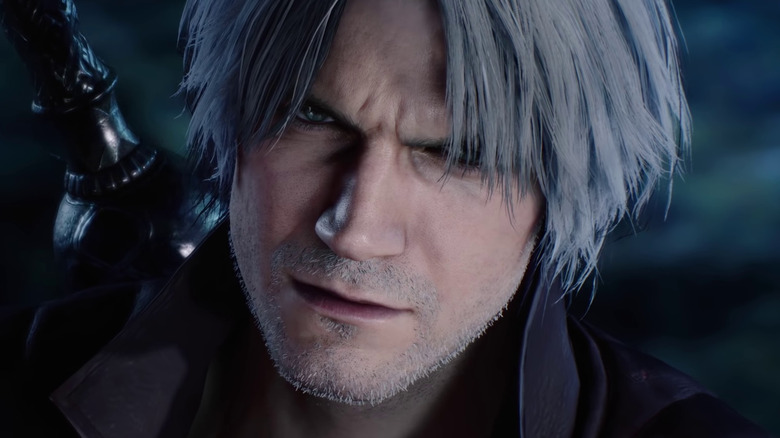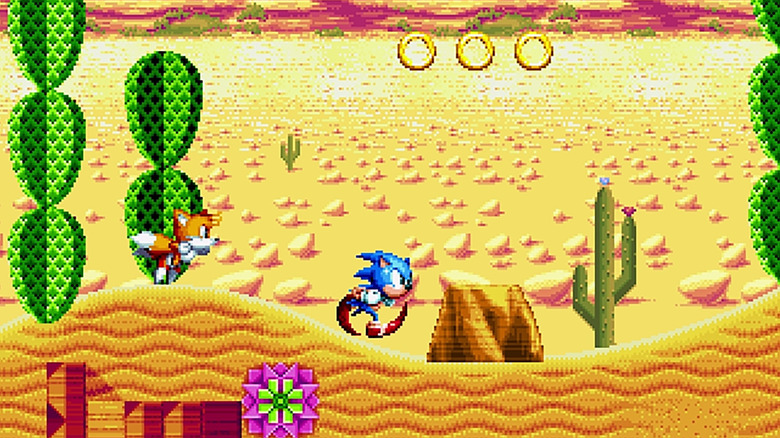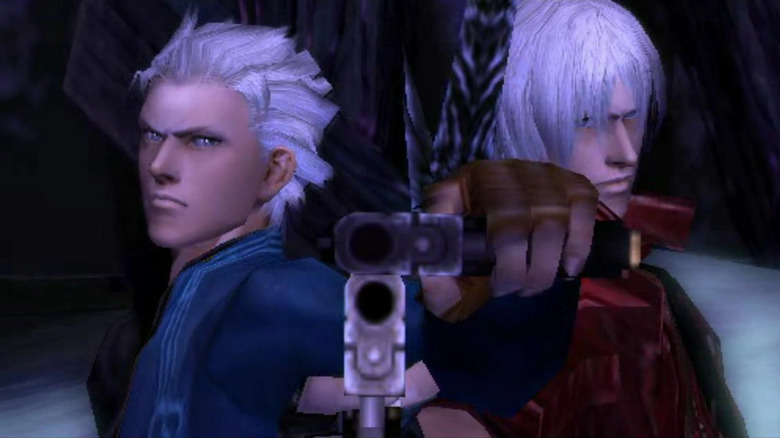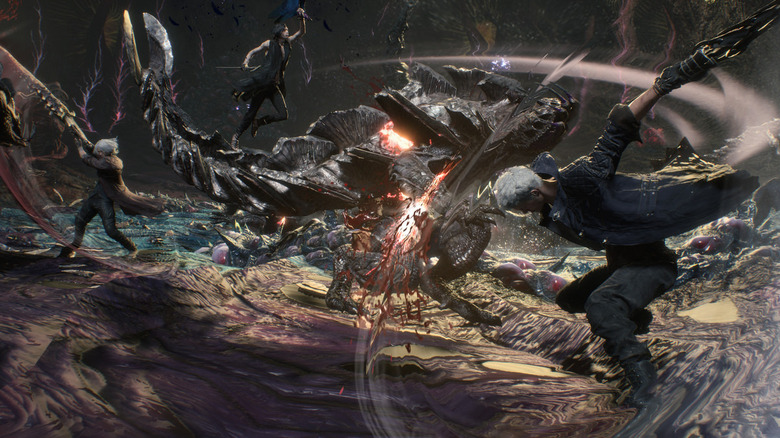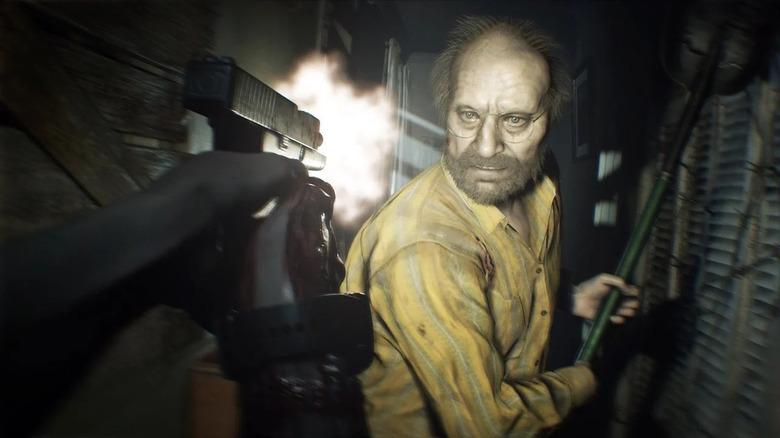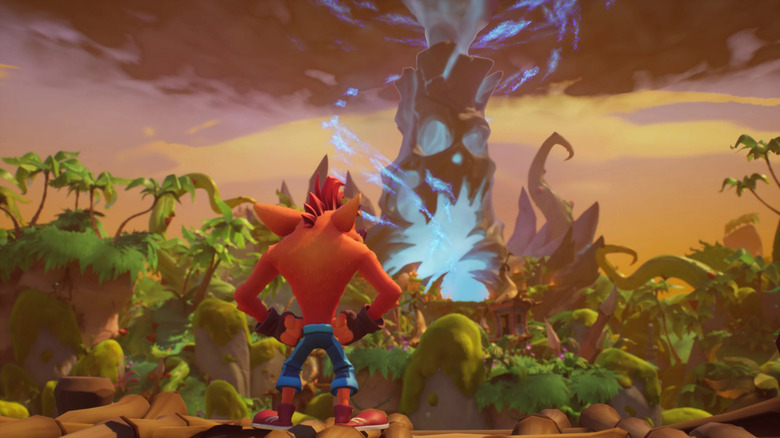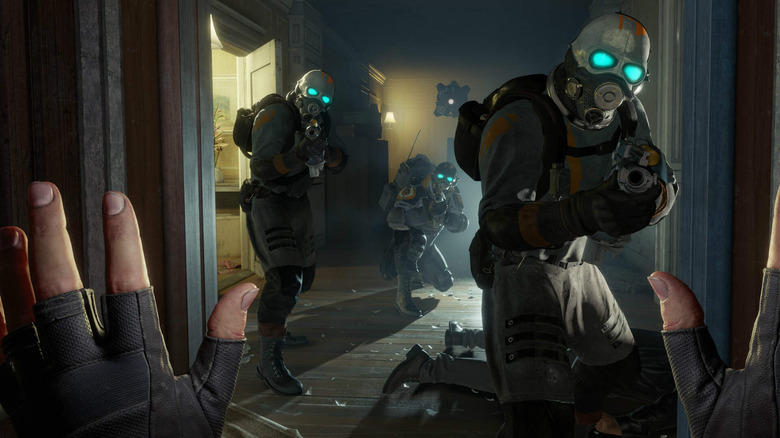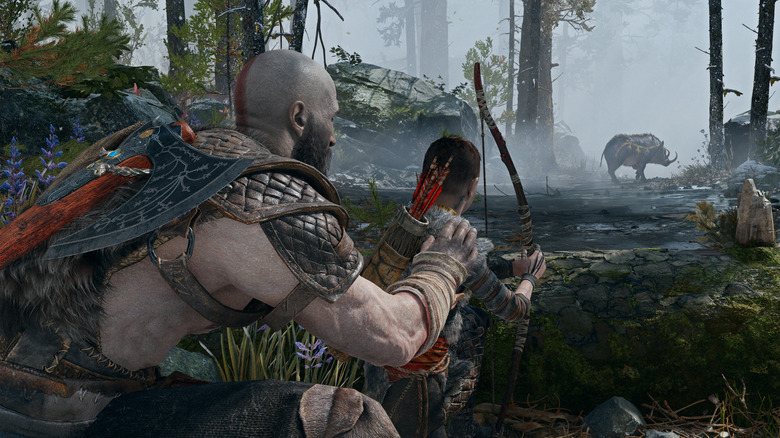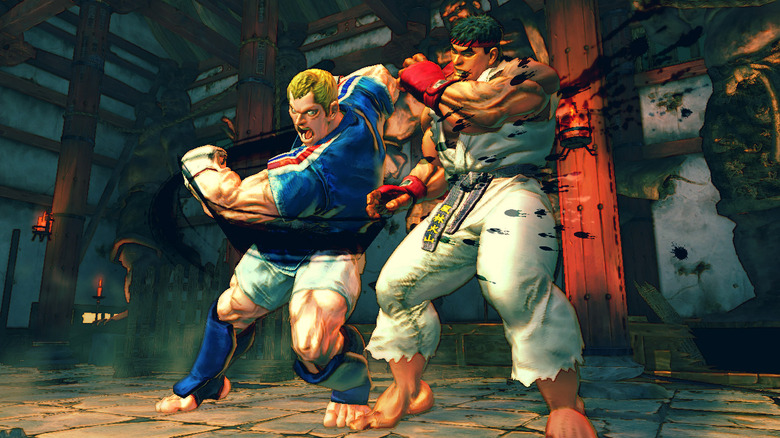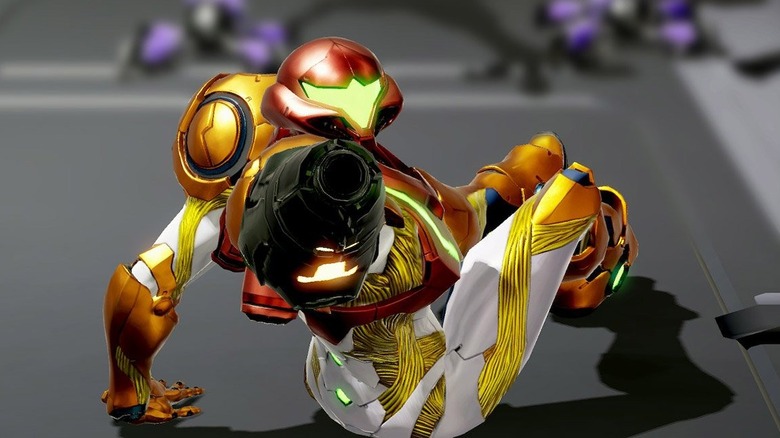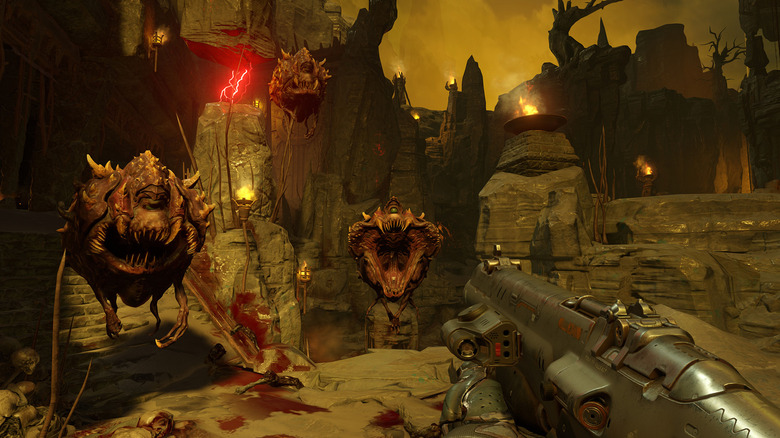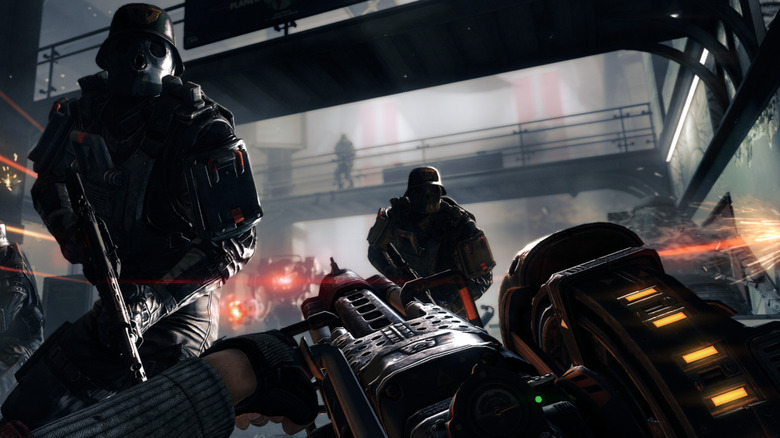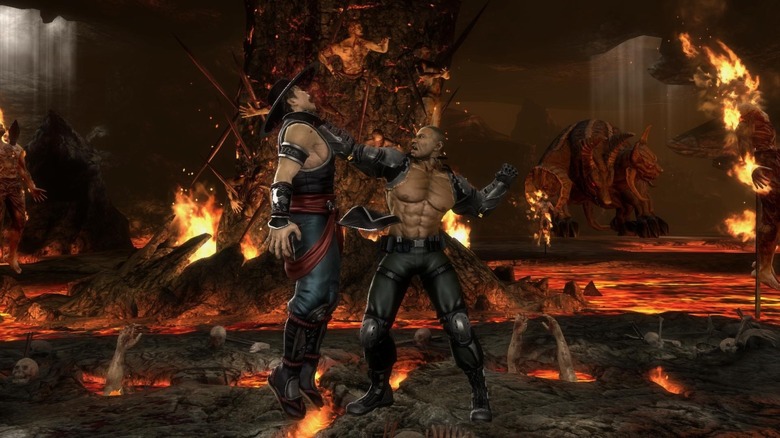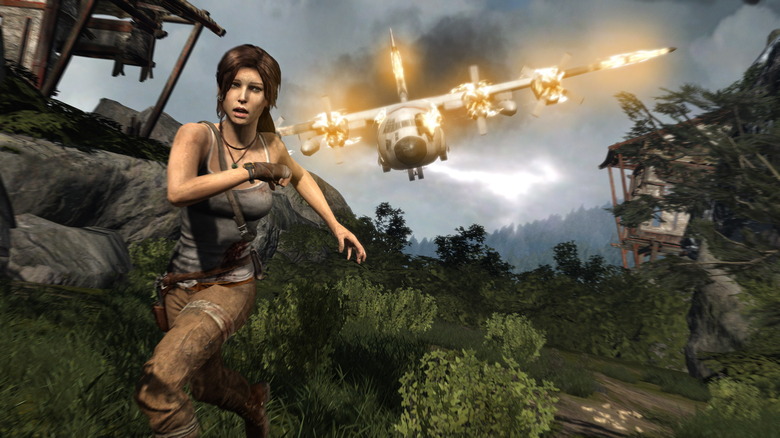Video Game Sequels That Saved The Franchise From Death
Consistency in a gaming franchise is a tall order. Some huge series, like "Mario" and "Zelda," have managed to avoid serious disasters, even though they've had serious ups and downs. But what about franchises that were magically resurrected when one great game broke up a spell of mediocrity?
Every year it seems like another legacy character tries to take the spotlight after a long absence. In 2022, "Sonic Frontiers" seeks to change the franchise forever with a new open world approach, while "God of War Ragnarok" is poised to continue the resurgence started by the 2018 reboot.
Causes for a franchise's near-death experience can range from a poorly-selling entry to a genuine drop in quality. But again, one great new iteration can flip the script! Whether that's due to a return to form or a fresh and innovative concept, fallen franchises have the potential to come back bigger and better than ever. Here are some great video games that breathed some new life into their respective franchises.
Sonic Mania
Sonic the Hedgehog revolutionized the 2D space with his initial outings on the Genesis and Sega CD. Things took a sharp turn, however, with games like "Sonic 06" and "Sonic the Hedgehog 4." These were seen as either poor attempts at retreading familiar territory, or buggy attempts at reinvention.
Sonic's 2D glory days were over — that is, until "Sonic Mania." A rebirth for the hedgehog, "Mania" remixed classic stages and threw in a ton of fun new levels. Players take control of Sonic, Tails, Might, Ray, and Knuckles. These aren't mere cosmetic differences, as gameplay shifts depending on the character, especially in the special edition, "Sonic Mania Plus." New moves like the Drop Dash allow for faster movement through the air, adding new strategies to platforming. On the music front, the new soundtrack was a high point thanks to some remixed classics and funky modern tracks. The graphics captured the classic vibes of the Genesis and still popped on next-gen consoles, while the bonus stages were revitalized with the new UFO Chase segments.
"Mania" hit all the right notes upon release and proved how awesome Sonic can still be.
Devil May Cry 3: Dante's Awakening
"Devil May Cry" was so good that it's difficult to believe the immediate sequel almost halted the series in its tracks. "Devil May Cry 2" was rushed into development right after "DMC 1" came out. Director Hideaki Itsuno was signed on in the middle of the development cycle to help salvage the troubled production, all to no avail (per Siliconera). As a result, "DMC 2" was an unfocused mess that dropped the ball in fans' eyes. Luckily, Itsuno was then asked to make "Devil May Cry 3," and managed to pull off the impossible.
The game sported an overhauled style ranking system that could be built up by the players' reflexes and ingenuity during battle. As noted by GameSpot, the combo system asked the player to implement every weapon and every ability when stringing together attacks. "Dante's Awakening" brought plenty of challenges to the table, including massive bosses and a slew of alternate gameplay modes.
The story was more coherent this time around, following Dante as he fights through a giant tower to stop the villainous Arkham and Vergil. Dante himself is a more fleshed-out character, trading the silent and angry vibe of "Devil May Cry 2" for a characterization that feels like a good mix of funny, cool, and corny. "Devil May Cry 3" found a way to stay true to the original while expanding on combat and level design, and it remains one of the best entries in Capcom's longstanding action series.
Devil May Cry 5
That's right: Capcom's supernatural action franchise found itself at death's door twice. "DMC 4" was not a big enough success for Capcom. As explained by Matt McMuscles, Capcom saw that sales were larger in the US than in Japan, so the company gave Ninja Theory the reins for a westernized version. "DmC: Devil May Cry" is a bit of a hidden gem, but it made the mistake of doing away with the classic interpretations of Dante and Vergil and packed in way more adult content. Fans were divided, to say the least.
So it was up to Hideaki Itsuno to save the day again. The resulting game may be the strongest in the series. "Devil May Cry 5" perfected the formula of the earlier entries, centering around three diverse playable characters spread across twenty missions. Combat is better than ever, and each character brings a totally different fighting style to the table.
Graphics were a big selling point at launch, especially with the game utilizing Capcom's realistic RE engine (per Destructoid). The soundtrack also rocks, and it's almost impossible not to get tunes like "Devil Trigger" stuck in your head. Lastly, the "Special Edition" brought in Vergil as a playable character, which upped the replay value of an already replayable experience.
Resident Evil 7: Biohazard
"Resident Evil 6" has been seen as a creative failure, and it was nearly a series killer. It was more focused on big action and quick-time events than horror, which ultimately affected the game's tone, story, and gameplay. Enter "Resident Evil 7: Biohazard," where the series got back on track. "Resident Evil 7" was a breath of fresh air in that it brought back the survival horror aspects. The game's switch to first-person also made the game's scares feel more immediate, and this terror is only elevated when played in VR.
Veteran protagonist Leon Kennedy sits this one adventure out, while Chris Redfield is relegated to the sidelines. Taking their place is newcomer Ethan Winters. But even though many legacy characters are absent, there's a ton of lore and story elements that tie to preceding games.
Many of the game's design choices were against Capcom's original demands for Resident Evil 7. Capcom wanted microtransactions, multiplayer and more, but the developers stuck to their guns in scaling this one back. Suffice it to say, "Resident Evil 7" ultimately benefitted from not having these elements. "Biohazard" was a huge step in the right direction, so much so that the series continued with many of its best elements in the critically acclaimed "Resident Evil Village."
Crash Bandicoot 4: It's About Time
Crash Bandicoot was the face of PlayStation for a while. Naughty Dog developed three solid games on the PlayStation One, and then the series was handed off to other teams. Sadly, as noted by Game Rant, none of these could meet the same quality as the first three, even though they have their fans.
Years later, hardcore fans got a glossy remake of the original trilogy, but this was just the beginning of things to come. In 2021, a Taiwan rating board helped leak the next Crash Bandicoot entry, stoking fan interest. Later that same year, Toys For Bob finally released "Crash Bandicoot 4: It's About Time." In many ways, this felt like the long-lost direct sequel to Naughty Dog's games that fans had wanted. Outlets like Kotaku praised it for keeping the original gameplay style and adding in new items, characters, and huge levels.
Although Crash's latest adventure stuck largely to the same corridor-heavy level design, there's a lot of new stuff to love. Masks help Crash alter gravity and time, and the levels are built around these mechanics. Each world ends up feeling unique among "Crash" games, let alone other platformers. "Crash 4" understood the assignment, delivering an experience that is as good — if not better — than the series' best outings.
Half Life: Alyx
Valve inadvertently dug itself a deep hole by making "Half-Life 2" an episodic game. "Episode 2" left things on a massive cliffhanger, paving the way for a continuation. Gabe Newell, president of Valve, claimed the next chapter was close to completion at one point, only to slowly walk back that statement over the years. "Half-Life 3" may never materialize, but the franchise got a second wind in recent years.
Renewed hope for the series came in the form of "Half Life: Alyx." Although a VR prequel/spin-off, "Alyx" is a "Half-Life" game through and through. The game's gravity gloves are a brilliant substitution for Gordon's infamous Gravity Gun, allowing players to seamlessly pull in items from all directions and quickly use them in combat. In a way, virtual reality is perfect for this game's aspirations and gameplay style.
Virtual reality can leave a bad taste in gamers mouths, especially since a number of titles can feel more like underdeveloped experiences rather than full games. Xbox head Phil Spencer has even echoed these sentiments by saying many VR games simply "feel like demos" (per Stevivor). "Half Life: Alyx" refutes these notions by delivering a lengthy campaign and high quality gameplay. Though a proper sequel is still up in the air, "Alyx" more than makes up for the hiatus.
God of War
For a long time, the "God of War" series was at the upper echelon of hack and slash games. Kratos, a spartan warrior, took down the Greek gods in one revenge-filled adventure after another. Slowly but surely, however, the franchise started to decline. "God of War: Ascension" followed up the legendary trilogy to decent reception, but it didn't blow anyone away and ended Kratos' PS3 adventures with a bit of a fizzle. Thankfully, in 2018, "God of War" returned in a modern revival with some twists.
Gone away were the distant camera and Greek aesthetic. 2018's "God of War" was now based in Norse mythology with an unbroken over-the-shoulder camera angle, but its brutal action roots remained. A new weapon, the Leviathan Axe, can be tossed and caught at will. Its wielder is the same old Kratos, but a more wisened version. Now he has a son to take care of, and he tries desperately to manage his temper and rage.
Few games can say they've re-envisioned classic series in the same manner that this "God of War" has. It's a journey that prioritizes story and action within a semi-open world. Exploration leads to moments of awe, whether those come from its somber character-driven moments or its over the top boss battles. It makes some courageous decisions, all while sticking with what made the originals great.
Street Fighter 4
"Street Fighter 2" was everywhere back in the day; anyone in the arcades during the 90s had a run-in with it at least once. "Street Fighter" was so popular that Capcom would re-release it many more times, capitalizing on various aspects of the groundbreaking game.
Though not gaining quite the same level of popularity as "Street Fighter 2," the "Street Fighter Alpha" series and "Third Strike" would keep the series afloat. "Alpha" was hailed as a series that added tons of characters and was "fun to come back to" (via GameSpot). Meanwhile, IGN has noted that "Third Strike" excelled at competitive, technical gameplay.
Then the dark ages began. "Street Fighter" would live on through occasional collections and an awkward transition into the 3D space, but it took a while to reclaim its former glory. That's why "Street Fighter 4" is so important to the series, and why Capcom found it to be a perfect foundation for multiple expansions and re-releases. A starting roster of 17 characters would gradually become a whopping 44 with the launch of "Ultra Street Fighter 4."
The 2.5D game boasted stylized characters, dynamic arcade modes, mechanics that demanded players master them. For instance, the new Focus Attacks can be charged and used to counter opponent attacks. Also, each character eventually received two super moves, giving the game more replay value as players learned how to properly utilize them. There's a reason "Street Fighter 4" reigned supreme from 2008 to 2014.
Metroid Dread
The early 2D "Metroid" games were a phenomenon, and their addicting and well-paced gameplay loop of exploration and action launched what would become known as the "Metroidvania" sub-genre. However, the series' 2D gloy days seemingly drew to a close with the last hurrah of "Fusion" and "Zero Mission," leading into a rather disappointing era. "Metroid: Other M" was a controversial continuation of Samus' story, while "Metroid Prime: Federation Force" was an underwhelming spinoff that garnered little praise from critics or fans.
"Metroid" would then enter a revival period with Mercury Steam, the team behind "Samus Returns," the 2.5D remake of "Metroid 2." Shortly after, Mercury Steam went on to produce the smash hit sequel, "Metroid Dread." "Dread" recaptured the magic that previous 2D "Metroid" games had. Samus explores planet ZDR and loses her abilities, which she must fight to regain. It follows the same tried and true formula while incorporating bold ideas. But what's really special about "Metroid Dread" is the addition of the E.M.M.I. encounters.
Over the course of the game, Samus will enter parts of ZDR that are being gate-kept by E.M.M.I robots. As noted by Nintendo Life, these portions of the game require accurate shooting and precise movement to complete. Old and new powers help make this feel like the ultimate "Metroid" adventure, not to mention a true return to form.
Doom (2016)
If there's any game that needed the modern facelift, it's "Doom." The original game was groundbreaking in its time, while the sequels added onto the story with better visuals and revamped gameplay. A fourth mainline game was then cancelled for not feeling like "Doom" at all. What ensued was a twelve-year gap with no "Doom." Sure, there were a number of ports, but they didn't satiate the fans entirely. 2016 marked the resurrection of a beloved first-person shooter franchise.
The new "Doom" kept things simple: Kill all demons in an area. The premise is familiar, but Bethesda and id Software cranked up the graphical fidelity. Lab interiors and Mars/Hell exteriors are rich in detail. And more importantly, exploding demons look better than ever, all set against a pumping metal soundtrack.
Doomguy has some new tricks up his sleeve for destroying these enemies. For starters, there are Glory Kills. When a demon gets enough damage, it begins to glow, paving the way for a gruesome take down. There are a whole slew of different animations for these kills and they never get old. Besides these, players will have a lot of fun acquiring and upgrading a whole arsenal of new weapons as the Doom Slayer goes from one fast-paced shootout to the next.
Wolfenstein: The New Order
The last game to come out before "The New Order" was just named "Wolfenstein." A 2009 reboot, "Wolfenstein" was a decent attempt at bringing this shooter franchise back into the limelight. However, critics were decidedly mixed. "Wolfenstein: The New Order" is when Machine Games and Bethesda kicked things into high gear. 2014's "Wolfenstein: The New Order" was successful enough to spawn even more projects.
"Wolfenstein: The New Order" combined stealth and shooting on top of an engaging plot. As noted by IGN, B.J. Blazkowicz is finally a fleshed-out character this time around, so the story is a highlight for once. Gameplay is similarly polished, as players will often find themselves dual-wielding weapons and figuring out which ones work best against different enemy types. Creating more depth and strategy is the thorough skill tree that will alter combat in exciting ways.
Machine Games and Bethesda knocked it out of the park, and spin-offs and sequels were inevitable. "The New Order" was succeeded by "Old Blood," "The New Colossus," and "Youngblood." Like 2016's "Doom" reboot, "Wolfenstein: The New Order" brought the IP back for more than just a fun one-and-done game.
Mortal Kombat (2011)
"Street Fighter" wasn't the only fighting series that underwent major changes. After years of forgettable sequels, plenty of poorly received spinoffs, and an unremarkable crossover with DC, the "Mortal Kombat" franchise was ready for a clean slate. 2011's soft reboot felt like a definitive fresh start for NetherRealm's gory tournament series. A heaping amount of content, tight 3D models, and some fun extras are all major factors in this series' grand return.
Fighting games are most commonly associated with their arcade mode, in which players take one character through multiple fights in rapid succession. 2011's "Mortal Kombat" also went all-out with its campaign mode, which featured extensive dialogue, cutscenes, and a time-bending storyline that continued from previous iterations.
Gameplay saw some tweaks too. Critics responded positively to the brutal X-Ray moves, which allow players to see characters breaking each other's insides in flashy ways. On the whole, "Mortal Kombat" brought back 2D fighting and amped up the presentation. Add in the Challenge Tower, online play, and Kratos as a playable character, and "Mortal Kombat 2011" remains a big stepping stone for the rest of the franchise.
Tomb Raider (2013)
Although the "Tomb Raider" series has seen a few missteps over the years — like the try-hard "Angel of Darkness" — the series has had a decent track record overall. Yet after the lukewarm reception of "Tomb Raider: Underworld," critics felt that the series was sorely lacking in innovation.
Save for the spinoff game, "Guardian of Light," there was a five year hiatus between mainline entries. It seemed like it would be a pretty tall order to restore "Tomb Raider" to its former glory. Finally, a reboot simply titled "Tomb Raider" was released in 2013. Thanks to a number of gameplay tweaks and an updated storyline, the new "Tomb Raider" was able to stand toe to toe against similar games like "Uncharted."
"Tomb Raider" is still a marvel in the graphics and gameplay department. You'll need to master both archery and gunplay to survive this action-packed adventure. Other gameplay elements include the traditional platforming and puzzle-solving from preceding entries, which have been made even more tense thanks to cinematic quick-time events that will have players on edge. And as noted by GameTrailers, the titular tombs are a major highlight, with both the main story tombs and the optional ones boasting deep and intricate designs.
This evolution of "Tomb Raider" revived the series in a big way, earning two direct sequels in the form of "Rise of the Tomb Raider" and "Shadow of the Tomb Raider." It's no wonder this reboot also inspired a new Hollywood adaptation just a few years later.

